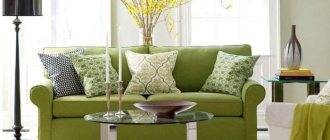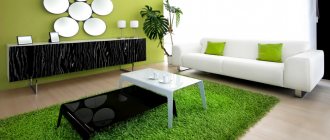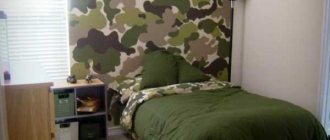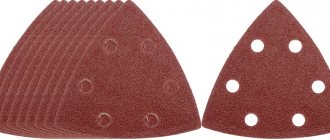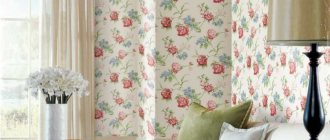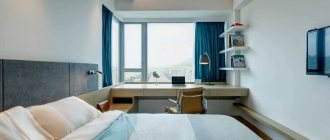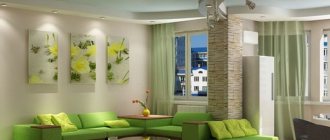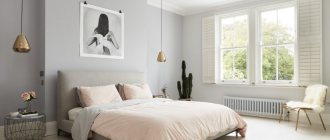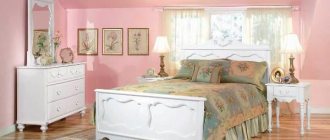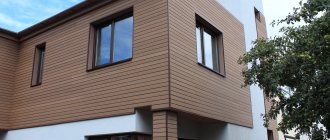What influences the choice of color in the hallway
The corridor is a place for light colors, unless otherwise provided by the overall design or original design. Due to the lack of windows (which is typical for almost all hallways) and compact size, it is customary to brighten corridors with the help of walls and rich artificial lighting. Searching for objects in a dark room is not very pleasant, so some people simply leave the light on all day long. If everything is clear with the ceiling - it should be light, then the color scheme of the walls depends on the lighting, textures, the presence of textured surfaces, and the need for combining shades. Size, of course, has its influence. In narrow spaces, light cannot spread well due to the darkness created by the walls. Pieces of furniture will cast shadows. So all these nuances should be considered along with the definition of the pros and cons of light or dark design.
Previous design experience is not always objective, because materials are constantly being improved, but it will definitely help you decide whether to use a particular color.
Hallway size
The shape of the entrance space tends either to be rectangular, as in two- and three-room apartments in Brezhnevka apartments, or it is square, as in most Khrushchev-era apartments. The optimal minimum width is 1.4 meters, and length - from 2.5. In such a corridor you can install modular systems and open storage. Hallways that are already 1 meter wide are almost always expanded, all that is needed is technical capability. Building codes provide for a width of 1.2 meters for places where the hallway opens into other rooms, and sections that are already a meter long are no more than one and a half meters long. All hallways consist of 2 parts - a reception area and an area for arranging communications. It wouldn’t hurt to find a place for a sofa, and in the spacious corridor of a multi-room apartment - for a large guest area similar to the hall. In locks with a height reduction of up to 2 meters, mezzanines are made.
Combination of materials
The hallway is decorated with one material or nice combinations. The first of these should be noted is the combination of wall panels and wallpaper. The walls of the loft hallway are decorated with whitewash and textured coverings, and sometimes bare walls with remnants of torn wallpaper are added to this ensemble. The technique of abruptly interrupting the brickwork has become traditional. In the classic version, elegant combinations are created with wallpaper, plaster, tiles and stone surfaces. Interiors in a modern style are made with the combined use of glossy, matte and satin finishes. The walls combine materials with a pleasant texture. Wood is combined with plastic and mirror polystyrene. Bamboo panels can be seen next to stone surfaces. The hallways are also finished with different types of wood coverings. Heterogeneous finishes, among other things, are used for zoning.
Texture and print of finishing
Some types of textures:
- Flat;
- Rough;
- Patterned;
- Geometric.
The corridor is usually left without a pattern if it is finished with panels. Oblong and compact planks are smooth and faceted in texture. Patterns usually cover glossy surfaces. Drawings and prints “get” into the corridors on regular and photo wallpapers, 3D compositions, panel films and painted walls. Fans of texture and color variety on surfaces should take a closer look at plastic. Imitations are made from the material, copying any raw material and repeating any colors. At first glance, natural wood, metal and stone cannot be distinguished from their plastic counterparts. Natural and synthetic materials are often painted white, creating solid monotonous surfaces. All those who like to personally participate in the design of their home should pay attention to paintable wallpaper.
Hallway illumination
A lack of light means a dull and unclear environment. Therefore, the corridor is either illuminated with several modern lamp options or with huge chandeliers. The main and additional devices of the modern type are mounted mainly on the ceiling, but extended versions such as linear ones are also installed on the walls. Wall sconces, which have recently appeared in any form, are also hung there. Products in a modern style look like boxes. They are assembled into compositions, directing light in different directions and using square and elongated devices. Grilyato ceiling systems have proven to be effective. Then a few spotlights on the walls are enough. Horizontal surfaces provide the best location for bendable strip lights with LED sources. In turn, the natural flow of light is organized through transparent doors or the absence of curtains in the interior passages.
Traditional hallway wall decoration
The choice of finishing materials depends on the style of the interior, the area of the hallway, the level of load on the room, and the available budget. Inexpensive methods of decoration - painting walls, gluing wallpaper, covering with panels that imitate natural materials.
Painting the walls
A quick option for finishing walls is to paint them with matte or glossy paint. Depending on the density and chemical composition, there are oil, acrylic or water-based paints. To decorate the hallway, several colors and textures are combined.
A quick option for walls is painting
A two-level combination of dark and light tones of the same range is suitable for decorating narrow hallways. Light paint occupies the upper half of the walls, visually expanding the space and increasing the illumination of the room. The dark shade is placed closer to the floor level, this protects the hallway from dirt and emphasizes the geometry of the room.
Universal combinations:
- sandy and chocolate;
- gray and blue;
- turquoise and bottle green shades.
The black and white color scheme requires a high level of illumination, so it is often found in spacious halls with windows.
Universal combinations - sand and chocolate
The combination of glossy and matte textures looks less noticeable than choosing contrasting colors, so it is suitable for miniature hallways. The transition between surfaces can be smooth (the classic two-level version), geometric (the glossy texture “protrudes” into the matte texture in the form of corners), or have a soft wave-like shape.
Glossy paint is used to decorate doorways, spaces around mirrors or lamps. The transition line is decorated with:
- textured plaster;
- glitter;
- thin strips of PVC film of different colors.
Beautiful decoration with lamps
Placing accents in a room is a way to emphasize the strict geometry of the space and add zest to a laconic classic interior. A dark shade of paint is used to decorate doorways, the area around the baseboards, and in some cases, ceiling fillets.
Advantages and disadvantages of painting
Painting the walls of the hall does not require large expenses, finishing is completed in a few days, the choice of colors and textures is huge. The main disadvantage of painting is the cost of purchasing special equipment and protecting furniture from drops of the composition. Cheap paints can be toxic; it is advisable for apartment owners to move out during the renovation period.
Choose only good colors
The combination of several shades and textures of paint creates an original interior; the plastic material allows for smooth transitions and placement of accents. The traditional hallway design combines dark and light shades of paint. Glitter glued onto drying paint will help you create a bright style.
Wall decoration with wallpaper
Using wallpaper in the hallway is the most budget-friendly and fastest option for cosmetic renovations in this room. The choice of texture, color scheme and width of the wallpaper roll is subject to the rules.
Wallpaper texture
Textured wallpaper
Rolls with a pronounced texture imitating wood, brickwork, textiles or plaster are suitable for owners of a hallway with smooth walls. Such wallpaper is heavy, looks flashy, and requires additional lighting.
Note: Light shades, fine shimmer or floral patterns are suitable for interiors in Provence, vintage, and hi-tech styles.
Owners of miniature hallways with a lack of natural light choose wallpaper with a glossy reflective texture, which visually expands the space. The abundance of “mirror” particles gives the interior an airiness and distracts attention from the furniture and decor. Such wallpaper is light, does not require leveling the walls, fits easily on a rough surface, and can be combined with most styles.
This wallpaper is suitable for large halls
Wallpaper based on natural materials:
- bamboo;
- silks;
- veneer;
- velvet;
- skin
Suitable for large halls decorated in the same style. For example, bamboo wallpaper is a bright attribute of eco-style; covering walls with imitation velvet is common in retro style.
Wallpaper color scheme
Plain wallpaper with sparkles, small geometric or floral patterns are suitable for modest-sized hallways. Warm sand, cream, sea or wood colors match most materials. Cool shades, bright colors, and an abundance of contrasts create a “luscious” interior, which is best complemented with furniture in light shades.
Photo wallpaper as a highlight of the hall
Photo wallpaper or materials with large patterns will become the accent of the hall; they require light furniture and plenty of lighting. For example, wallpaper imitating antique engravings or maps is combined with budget furniture made of light untreated wood.
The “natural” color range includes shades that are pleasing to the eye:
- green;
- brown;
- blue;
- red;
- beige flowers.
This type of decoration requires additional floor lamps or sconces and creates an interior in a restrained classic or minimalist style.
Artistic types of wallpaper
Among the unusual ways of decorating walls, photo wallpapers stand out, which turn the walls of the hallway into finished paintings. The material is suitable for owners of small, well-lit corridors with miniature furniture. Photo wallpaper is the accent of the hall, so the decor is placed around it without violating the integrity of the picture.
Artistic views
Wallpaper using 3D technique creates a three-dimensional image, which is placed on one of the walls of the room in compliance with the rules:
- The image must be abstract. Flowers, animals, landscapes, geometric compositions will not overload the interior or tire the eyes of the owners.
- The color scheme and general style of the design should resonate with the rest of the interior. For example, if the entire apartment is decorated with “rough” textures in dark shades, a bright industrial landscape will become the center of the hallway.
- Place wallpaper on a free wall; the amount of furniture and accessories should be kept to a minimum. Otherwise, the hall will be overloaded with details, and the overall impression will be disrupted.
Bright but stylish element
Advantages and disadvantages of wallpaper finishing
A simple way to update the finish is available for hallways of different sizes; wallpaper has many textures and colors, and is easy to replace if damaged. However, high-quality wallpaper has a high price, the finishing procedure requires time and skill, and the material is sensitive to moisture.
Restraint of the interior
Decorating a hallway with textured wallpaper in neutral shades is a universal option for updating an interior with an abundance of wall accessories. Artistic wallpaper creates a bright design; the textured material is suitable for a minimalist finish. The combination of several colors and textures will visually expand the hallway and place the necessary accents.
Paneling
The panels visually reduce the unevenness of the walls in the hall and are suitable for owners of apartments in the “old building”, owners of country houses with exposed wiring. Paneling does not require preparatory work; it is carried out quickly and renews the room . There are several materials for wall panels.
Plastic panels
An inexpensive and durable material for decorating a hallway, which improves sound insulation in the room and is not susceptible to moisture.
Plastic panels in the interior
The visual design of PVC panels is varied: the surface is decorated with drawings, patterns, and a glossy or matte coating is used. The finish can imitate a wooden, plastered, or textile wall.
The combination of glossy panels in a rich shade and paintable wallpaper in a neutral tone creates a neat, durable finish.
Chipboard and MDF panels
The material is suitable for decorating a hallway in a Scandinavian style, giving an unobtrusive retro flavor. Such panels imitate the surface of wood, are made in neutral shades, and are combined with eye-catching accessories.
Wide panels with tight joints
Advice For owners of small hallways, it is better to choose wide panels with tight joints that look like a single piece.
Light wooden panels can completely cover the walls of the hallway in country, Provence, and retro styles. Carved decorations made of natural wood will give the room a touch of classic antiquity.
What paints should I use?
To use paint and varnish material in a hallway or corridor, it is necessary to pay attention to the basic qualities and characteristics of the paint, since this will ensure long-term operation of the coatings, protect the walls from mechanical loads, the influence of liquids and other contaminants characteristic of this room.
Features of corridors and hallways:
- Location near the front door, which implies frequent sudden changes in microclimate and temperature, drafts. This destroys the coating with insufficient elasticity.
- Outerwear, shoes, umbrellas, and hats are often removed and left in the hallway or corridor. In bad weather, these things are often wet and dirty, which, as a result of moisture coming into contact with the walls, will directly put a load on the surface of the walls located close to the hangers. Paint and varnish coatings must have good wear resistance.
- Through the corridor and hallway, all objects enter the apartment: furniture, other large items. It is rarely possible to apply them without damaging the walls as a result of impact or friction, so the paint must form a durable film.
- Due to the openness of corridors and hallways to other rooms and spaces in the apartment, owners have to come into contact with evaporation from the walls, which should not be toxic or harmful. Intermediate spaces should be painted with paints intended for use in residential buildings.
The best paints for decorating walls in hallways and corridors are water-dispersed paint compositions. They have all the necessary properties and are vapor permeable. Let's consider the types of this category of material.
Acrylic
High-quality but expensive paints and varnishes for interior decoration. They are resistant to direct exposure to UV radiation, vapor and moisture permeability, and film strength.
Due to its high drying speed and color retention, regardless of the operating conditions of the room, the paint forms a soft, even coating that can hide even small cracks as a result of painting.
Butadiene styrene
Budget materials that are suitable only for interior work in rooms exposed to moisture, liquids, and other contaminants on the walls. It is necessary to take into account that the paints of this series are not resistant to sunlight.
As a result of prolonged contact with UV radiation, surfaces painted with water-based butadiene styrene paints acquire a pronounced yellow tint.
Polyvinyl acetate
These paint and varnish compositions are cheap, with the most modest moisture resistance indicators. They should be used in rooms where contact with moisture is minimized.
Alkyd enamel
The peculiarity of the coloring composition is the presence of toxins of organic origin. When painting a room, a persistent, very unpleasant characteristic odor is created. To eliminate this effect, you need to intensively ventilate the treated rooms for at least 3-5 days.
You can find odorless alkyd enamels at a higher price due to the composition with polyurethane-based additives.
Photo of dark corridors in the apartment
A dark palette allows you to set a certain shape and mood for the room, as well as impart nobility and sophistication to the interior.
Finishing materials in dark colors will provide an excellent background for furniture items. Such a rich color scheme does not create dissonance in the room and highlights every item and accessory in the room, giving them a clearer look.
Dark walls become an advantageous addition to a corridor in fusion, art deco or other eclectic styles, characterized by bright contrasts and a combination of incongruous elements.
The photo shows a large hallway in dark shades in the interior of the apartment.
It is believed that black shades make the atmosphere gloomy and visually make the room smaller, so such colors would be extremely inappropriate for decorating a small hallway. However, a spacious corridor in black, in combination with well-chosen furniture and proper lighting, will look very fashionable, expensive and elegant.
Dark tones have invaluable beauty, are distinguished by originality and aesthetics. In the design of the corridor, it is important to use deep cobalt, dark blue, complex purple colors or mysterious shades of indigo, which give the enclosed space a certain depth.
An expressive burgundy color scheme will add special aesthetics and sophistication to the decor.
Hallways in light colors
One of the main advantages of a light color scheme is its ability to visually expand spatial boundaries and make the room brighter and more comfortable.
This palette goes well with all shades. Against the background of a light wall covering, various decor and accent details look more advantageous.
The photo shows the design of a hallway with light walls covered with peach-colored paint.
Pastel colors fill the room with calm, cleanliness and freshness. An entrance hall in soft blue, lilac, pale green or ivory tones always has a well-groomed and pleasant appearance, and also has a warm and homely atmosphere.
Painting the walls a neutral beige or light gray will make a small space feel much larger and larger.
The photo shows the blue and white decoration of a small corridor in the apartment.
Brown corridor
Chocolate color combined with wood texture will create a respectable corridor design. Brown is considered a classic choice for people with conservative tastes.
The most popular color solutions include coffee colors, shades of cocoa or cinnamon, which have extraordinary softness and warmth.
The photo shows brown colors in the design of a spacious corridor.
Hallway in gray tones
The corridor in gray has a rich range that harmoniously combines with other tones. Thanks to such combinations, the interior will never be oppressive and faceless.
Gray is quite practical. Metallic, graphite, pearl colors or a shade of wet asphalt have a positive effect on the environment, promote relaxation and relieve tension.
For decoration, it is better to use a lighter ash and smoky palette. Such a hallway in gray always looks airy, fresh and spacious.
The photo shows the interior of a modern hallway in gray tones.
Hallway in white
Snow-white colors fill the corridor space with cleanliness, volume, comfort and give dark furniture or decor additional brightness and attractiveness.
Just as outerwear and sometimes dirty or wet shoes are removed in the corridor, the white design will quickly lose its impeccable appearance. Therefore, ivory shades are suitable as an alternative option. They look rich, harmonize well with other colors and add presentability to the interior.
The photo shows the design of a corridor made in white.
Mint color in the hallway interior
If you choose the right companion colors for the delicate mint color scheme, you will be able to create a fairly harmonious color composition that will match the dimensions and decor of the room.
The mint palette is effectively combined with white, grey, blue or gold tones. For modern design, a combination with red would be appropriate.
Hallway in beige tones
The most comfortable and warm color that fits perfectly into the corridor space and creates a pleasant atmosphere in the room.
Beige walls will go well with floor or ceiling cladding in restrained and natural brown, white or gray tones.
The photo shows a corridor in beige shades with splashes of white.
Turquoise color hallway
The turquoise interior is original and catchy. The natural shade of turquoise, combining heavenly radiance and sea waves, gives the atmosphere an attractive charm and freshness. This color gives the hallway a discreet luxury, and thanks to different color duets it allows you to create an interesting visual effect in the room.
Hallway ideas in bright colors
The hallway in an apartment or house is a great place to create expressive touches and bold color experiments. Extraordinary color solutions due to a short stay in the hallway will only have a positive effect on the surrounding space and add special tone and effectiveness to it.
For example, bright red tones will not leave anyone indifferent and will undoubtedly attract attention, orange will create an optimistic, positive and bright atmosphere in the corridor, and pink will at the same time add richness, solidity and intimacy to the hallway.
Yellow, lemon or mustard colors have a charming warmth and, due to their good compatibility with other color palettes, provide the opportunity to realize original design ideas and ideas.
The photo shows the interior of the corridor, decorated in red.
General finishing rules
The hallways in city apartments have a modest size, are not equipped with windows, and open into a common corridor. The furnishings of the room include a closet or hanger for seasonal clothes, a mirror, a chest of drawers or a shelf for storing keys. Owners of spacious apartments or country houses complement the decor of the corridor with banquettes, chairs or sofas.
Option for wall decoration in the hallway
The difficulty of decorating a room is the need to fit pieces of furniture in a narrow space without interfering with the opening and closing of doors that open into a common corridor. Before purchasing materials, you need to choose the color scheme and texture of materials that combine with each other.
Color spectrum
A simple option is to decorate the room to match the tone of the entire apartment; it is recommended to choose slightly lighter shades to visually expand the space. Neutral tones :
- beige;
- sand;
- grey;
- aquamarine.
Can be combined with different finishing styles and a large number of accessories.
Bright contrasting patterns, floral or ethnic motifs in decoration will suit owners of spacious apartments. Such wallpaper requires moderate decoration of the room with mirrors or paintings.
Use bright elements in the hallway
Traditional beige or creamy colors are suitable for any apartment. Shades add visual “warmth” to the interior and smooth out the low level of illumination in the room.
Traditional beige or creamy colors
Cold tones are combined with an abundance of mirrors, requiring the installation of additional lamps; the interior as a whole looks more “airy”.
In cold colors
Unusual finishing colors form the interior in eclectic, hi-tech or loft styles. A bright room in red, orange, turquoise shades attracts attention and becomes the accent of the entire apartment.
Unusual finishing colors
The color scheme of the wallpaper should match the shade of the door panels that are placed in the hallway.
- Most doors are designed to look like wood, so walls in brown, beige or sand shades will form a harmonious ensemble with the canvases.
- Owners of transparent or frosted glass doors are free to choose a color scheme.
- The hallway in an apartment without installed door panels (for example, in a studio) should be finished in the same shade as the rest of the rooms.
Selecting a texture
The smooth texture of wallpaper, plaster, wood, tiles or paint does not attract unnecessary attention to the walls. The interior is given expressiveness by a bright shade of the walls, additional decor, and large accessories.
Smooth texture of wallpaper, plaster, wood
A pronounced volumetric texture is characteristic of decorative plaster, wood panels, plasterboard or plastic. It is chosen as an accent, while the rest of the decoration should be discreet.
For example, if the doorways in an apartment are finished in the form of round arches (without door panels), the pronounced texture will emphasize the boundaries of the room. Owners of traditional hallways with an abundance of doors are advised to choose voluminous textures and light, monochromatic finishes.
Volumetric texture combined with calm tones of the walls
The texture of natural material (or its imitation) is suitable for eco-style, Scandinavian or minimalist interiors. Wooden, stone or ceramic panels are combined with most accessories and “fit” into loft, hi-tech, Provence, and classic interior styles.
Combination of materials
The overall style of decoration depends on the size of the hallway and its level of illumination.
Owners of standard mini-corridors, which house the entrances to all areas of the apartment, decorate the walls with a combination of two materials. Usually these are plain wallpaper and wide wooden baseboards in light shades, which are in harmony in color and size with the ceiling fillets.
Combination of several materials
Apartments with spacious halls that open into a corridor can be decorated with several materials . For example, the combination of wooden panels in the lower half of the walls and wallpaper in the upper half creates a retro-style room. Hallways in country houses for large families are decorated with durable artificial stone and plaster.
Classic version
Large, bright hallways, halls in the “old building”, private houses and spacious apartments are equipped with separate windows. The walls in such rooms are decorated with several materials:
- artistic painting (frescoes);
- stucco;
- miniature niches with statues.
Methods of combining materials
The walls are finished with wear-resistant materials, the lower part is decorated with wide wooden baseboards, panels made of artificial stone, and hard wood. This protects the surface from mechanical damage.
The lower part can be decorated with wide wooden baseboards
Bright textures made of artificial or composite materials (fiberglass, ceramic tiles, laminate, textured plaster) create accents in the interior. For example, tiles, frescoes or figured wooden panels are used to decorate doorways and decorative compositions.
Materials that contrast in color or texture create a strict, classic interior. For example, the combination of light textured plaster with lacquered dark walnut panels creates a vintage flavor to the room.
Advice Thick non-woven wallpaper in combination with wide plastic skirting boards and fillets are suitable for a modest-sized hallway. Small ornaments, laconic colors and the shine of such wallpaper create an “elegant” hallway.
The hallway walls set the style of the room
The decoration of the hallway walls creates the style of the room and visually increases its size. Finishing materials must be combined in color and texture. Surfaces are finished:
- skirting boards;
- dumbbells;
- wallpaper.
I use wooden or stone elements as decoration. Owners of spacious halls with windows add frescoes, niches, statues, and a dense layer of textured plaster to the design.
Light and color
The next factor influencing the main tone of the hallway is its illumination. The main thing here is to follow the rule: the brightness of the walls is directly proportional to the amount of light in the room. If the hallway has a window facing the sunny side, or the lighting scenario is well thought out, then the choice can be made in favor of:
- blue;
- green;
- indigo;
- sea green;
- turquoise;
- purple.
A dimly lit hallway should be decorated in light colors.
What designers do not advise doing is choosing white, since in low light it becomes dull and, over time, also “dirty.” White is a “reflector” of daylight, and when there is nothing to reflect in your hallway, it is better to give preference to another shade.
Wallpaper for a small corridor
Some tips:
— you can level the walls and make them beautiful using liquid wallpaper;
- the walls in a narrow corridor should be painted in light, bed colors - the room will become lighter and visually wider;
- if you choose wallpaper, it is better with horizontal stripes, as they visually expand the space;
- for a small corridor, as well as for a long narrow corridor, wallpaper with a small or abstract pattern is suitable - they can hide some stains that may appear.
The use of light colors to visually expand the corridor has already been mentioned, but some people do not like such tones.
If you want to use bright colors, you can wallpaper with a large pattern, but it should only be one whole pattern. In this case, it is desirable that the furniture in the corridor be light and monochromatic.
How to combine colors in the hallway
When decorating any room, you need to be guided by the “three-color rule.” This means that you need to decide which color will become the main color and which two will be additional.
If the hallway is designed in a neutral color and without bright accents, then you can choose combinations of colors similar in palette, for example: milky and beige, brown and gray, turquoise and blue. Soft transitions from one color to another will not irritate or bother you.
In cases where contrast is required, white will be an excellent match for any of the bright colors. The combination of walls in rich, rich colors and white furniture and doors looks very impressive. In such cases, it is better to make the ceiling and floor neutral: for example, bright yellow walls will harmoniously combine with a grayish ceiling and light gray-brown flooring. If the furniture is bright, then the best background for it will be light walls - for example, in a light gray hallway you can “settle” a cheerful green wardrobe or an orange pouf.
Accessories in black, dark brown or dark gray will help create contrast in the interior. They can be unusual modern lamps, an original hanger for outerwear, as well as framing pictures or mirrors.
Wardrobe in a small corridor
Wardrobe
As a rule, scrupulous people use the wardrobe in the hallway, while others simply hang their clothes on hooks or throw them on the seat.
Only when a huge amount of outerwear has accumulated on the hooks do people begin to hang it in the closet.
It is not necessary to install a wardrobe in a small corridor. It would be better to install it in a room where there is plenty of space and where you can fit a nice large closet for a lot of things.
Closet
A sliding wardrobe today is considered an integral part of any corridor, even small ones.
* If you install it in a “Khrushchev” building, then it is better to order a shallow cabinet with a mirror to visually increase the space.
* Such a cabinet will fit perfectly into a narrow corridor and will not serve as an obstacle to moving around the house.
* A wardrobe in a small corridor can be mounted in a free corner or installed parallel to the wall.
* The best option would be to purchase a tall cabinet, as it will use up extra space, which means more things will fit in it.
You can store out-of-season items at the top of the closet, and place space for shoes at the bottom. You can install a hanger rod in the middle.
* A corner closet or hangers, shelves or cabinets are also ideal for a small corridor. Corner built-in wardrobes allow you to use the space in the corners.
Typically, corners are left unused when conventional cabinet furniture is installed.
What about shoe furniture?
In stores you can find various samples of cabinets and shelves for shoes. There are shelves, revolving, sliding
and other shelves for shoes, but it is better to choose ordinary shelves that do not have any holes or simply lay rubber mats for shoes.
* It is worth noting that after snow or rain, when you come into the house, slush flows from your shoes, which can fall on other shoes on the bottom shelf, so all sorts of stacked shoe “storage” options are suitable for slippers or shoes that you are temporarily not wearing .
*You can also use regular stools, benches or cabinets with a cushion so you can sit down and change your shoes.
Textures and prints
Do not forget that the textures of finishing materials can also help achieve the desired visual effect. Nowadays, wall decoration with natural wood is gaining popularity, since it is not only an environmentally friendly material - it does not require perfectly aligned walls, and well-chosen shade and pattern of wooden panels will help expand the space of a small hallway, making it cozy and warm. Decorative brick and plaster finishing does not lose its position, but it will look better in large hallways, where there is a need for zoning and you don’t have to be afraid that the finishing material will “steal” a certain amount of space.
It is also worth paying attention to the ombre effect, which will help make the hallway unique.
As for prints, when decorating a hallway they can both play a cruel joke and correct the shortcomings of the room. So, horizontal stripes will visually expand the space, and vertical ones will raise the ceiling a little higher (a white horizontal stripe on the wall along the ceiling has about the same effect). But it is better to avoid overly variegated or large patterns - they will visually make the hallway smaller and will most likely quickly begin to get on your nerves. More useful interior design tips →
What color should I paint the hallway of an average apartment?
The abundance of offers in the paint and varnish industry is so great that it will not be difficult for buyers to purchase any shade they like. But how well will it fit into the current interior? The answer to this question can sometimes be very difficult to find. The soul often wants one thing, but reality dictates completely different conditions. And it’s definitely worth listening to them if you want to get the most favorable environment in your home. An unloved color will very quickly begin to cause irritation, so it will have to be changed in any case. Why go to extreme measures if you can achieve excellent results the first time.
The generally accepted “ideal” colors for a corridor are:
- Light brown;
- Powdery;
- Light shades of green, lilac and even red.
For those who are not sure what their home will look like in a few years, a light brown shade is perfect. It can be “made friends” with any element in the apartment and, if desired, it can be advantageously changed in intensity.
Other, more “colorful” tones are quite pretentious and do not always look harmonious in the hallway. They should be chosen only in cases where the entire house is built in a similar concept. Then the chance of making a mistake is negligible!
Choosing the right wall color
In most cases, hallways are small. Basically, these are square or elongated rooms. The small area limits the choice, but there are criteria that should be taken into account:
- Area and layout of the premises. The smaller the hallway, the brighter the interior should be. A large corridor in a private house can be decorated in shades of dark colors, but for a small room it is worth choosing lighter shades.
- A stylistic direction that is used for interior design. Each style has characteristic features that you need to use to create a beautiful and stylish hallway.
- Features of the layout. In order to visually reduce a long corridor or increase the height of the ceilings, you should choose wallpaper with vertical stripes. To lengthen the room, a horizontal strip on the walls is suitable.
- Lighting affects the overall perception of the interior. Many corridors lack windows; the lack of natural light can be compensated for by placing artificial light sources. Good light will help highlight the color of the walls.
- It is not recommended to use more than 3 shades to decorate a hallway.
When choosing materials, it is worth considering the load on this functional area. Every day residents leave the house and return back. Depending on weather conditions, wet clothes, dirty shoes and wet umbrellas may appear in the hallway. Preference should be given to materials that are resistant to dirt and moisture. It would be appropriate to replace the snow-white shade of the walls with beige or cream.
DIY surface painting
Let's look at how to beautifully and correctly paint a surface. Before finishing, a style is determined, which will dictate the number and type of wall covering colors used. Popular:
- Rococo - golden, pink, cream shades are combined.
- High-tech - reflected in elements and coatings of monochrome, metallic tones.
- Minimalism is a combination of pastel, black, pure white colors (how to paint a wall white?).
- Baroque is one of the luxurious styles that requires finishing in turquoise, blue and white colors.
- Modern, classic - created by a combination of pastel, green, white shades.
Most of all, the type of style is influenced by the number of square meters of the corridor and hallway. This must be taken into account so that the decoration does not look ridiculous or have a contradictory effect.
The number of main color finishes is arbitrary, but most often does not exceed three. The geometry and size of the room influence this indicator. For cramped hallways and corridors, it is recommended not to overload with colors, use no more than two with vertical or horizontal stripes to create the desired visual effect.
Large hallways can be painted in several colors, since they play with geometry and even zone. You need to adhere to the principle of combining three shades so that the interior remains cozy.
In a small room
Tight spaces should be finished only with safe compounds, since the likelihood of contact with the surface of the walls is very high.
How to choose materials for decorating a small corridor or hallway:
- It is better to use 2 colors to create the effect of expanding the space.
- The corridor will be made higher by applying vertical lines alternating with the main tone of the coating.
- Panels mounted horizontally or decor that differs from the main color of the finish can create the impression of a wider space.
- Dark tones will make small rooms even more cramped, so preference should be given to light shades of brown and beige with decorative inserts in white and milky tones.
- By applying a white stripe 10-20 cm wide under the ceiling, you can visually raise it a little.
- The use of chrome elements and mirrors is another way to create the illusion of more space than it actually is.
- To create a cozy and warm atmosphere, wood or other natural materials are very good.
Important
An entrance hall or corridor is a functional space designed to keep an apartment or house clean. It is necessary to think very carefully about the arrangement of furniture and decor in order to achieve the optimal combination of space and spaciousness of objects.
In the large hallway of the apartment
The advantage of large hallways and corridors is the variety of design solutions. In a spacious room, you can create a design with bright expression, zoning or color accents. For a classic style, paints in olive, turquoise, green or delicate light green shades are suitable.
Creative and daring individuals will appreciate designs that include contrasting color combinations. It is necessary to take into account the combination of shades with each other when designing, so it is better to entrust the selection to a designer. The basis of contrast is the combination of colors for the walls and their selection for finishing the floor and ceiling.
Universal colors, their features
The hallway connects the apartment or house with the outside world. Only the necessary furniture intended for storing clothes is placed in a small area. You can decorate the room by decorating the walls and using a small number of decorative elements.
As the main color, you should choose universal shades that look harmonious in any interior; you can easily match them with bright decor. The main color should occupy about 70% of the entire interior, the number of bright spots should not exceed 30%.
Universal shades that are perfect for hallway design include:
- light yellow;
- beige;
- sand;
- terracotta;
- cream;
- peach;
- mint;
- grey;
- pearl gray;
- coffee with milk;
- lilac.
Gray tones combined with beige, many mirror surfaces, and white accents allow you to create a stylish interior. Gloss and many mirrors visually increase the space. Depending on what effect you want to achieve, you should decide what color to paint the corridor.
Shades of bright colors enliven the interior and give it a mood. Painted mustard walls highlight the neutral beige doors and brown wardrobe. Despite the lack of lighting, the hallway is warm and cozy.
The optimal solution for decorating a hallway is natural shades chosen for the base, and bright spots that dilute the boring design. The living space, the design of which is made in a single color scheme, looks stylish and complete.
The color difference allows you to harmonize the interior, which also gives the interior a sense of dynamics. For this purpose, various combined colors or several shades of the same color are suitable.
Style features of flowers
In a Provence style interior, color plays a decisive role. The main range here is pastel white, beige, cream and other muted and seemingly faded tones.
A corridor in a loft style is characterized by neutral white, gray or brown colors. For a more interesting design, this palette is diluted with bright purple, red, green and other rich colors.
The photo shows a loft-style hallway in brown, gray and white shades.
The hallway in the classic style is distinguished by its light design, combining white, cream, beige or light green colors. Snow-white, milky or almond wall cladding very harmoniously complements the classic direction. Light shades with the addition of gold or silver look truly expensive and luxurious.
Classic style - colors for walls
When you need to design an interior that will remain relevant for a long time, you should give preference to the classic style. This direction is characterized by rigor, elegance and functionality. Natural materials are ideal for finishing and decorating a room:
- Fine wood or stone tiles, such as marble, are suitable for the floor.
- They make stucco on the ceiling.
- It is better to choose plaster cornices.
- For walls, paint with a matte finish, wallpaper with ornaments, and decorative plaster are suitable.
Designers advise painting the walls in the corridor:
- white;
- gray;
- beige;
- olive;
- burgundy;
- brown;
- purple.
The classic style welcomes light and muted colors. Plain wallpaper, Venetian plaster, and paint are suitable for wall decoration. The hallway should be painted in a single color scheme; the material may contain a light pattern or design.
Carvings, columns and stucco will help complement the monochromatic design. Also, as decoration you can use natural materials, mirrors, luxurious wall lamps, which will be combined with the main lighting fixtures in the corridor.
In the presented version, the walls are painted with beige paint, and black and white tiles with squares were used to decorate the floor. Mirrored cabinet doors increase the space and, by reflecting the flow of light, create interesting shimmers. To decorate the hallway, we hung a luxurious chandelier and installed a decorative vase in the corner.
Light shades are better than others for decorating a hallway in a classic style. In combination with light furniture and decorative elements, the interior looks luxurious and majestic.
Shades of dark colors can be used for spacious hallways. It is important to provide good lighting that will highlight the chosen wall color or pattern.
The walls of a traditional classic hallway are predominantly light and warm. All details are harmoniously combined with each other; there are many unusual and beautiful decorative elements in the room. Neoclassicism is characterized by a wider range of colors. Contrasting colors and bright details can be used.
Color combination
A good idea for decorating a narrow corridor is a combination of shades with the same temperature, with varying degrees of saturation, as well as a composition of shades adjacent to each other on the color wheel.
This gradation will be especially beneficial in a small hallway. On the opposite side, you can use the darkest option: coffee brown or granite tones. In turn, the ceiling, floor and furniture should be light, this balances the contrast.
More: Scandinavian style hallway interior
In color combinations - in addition to choosing the right shades - proportion is also important. If we choose three shades, it is recommended to distribute them at 70% (neutral), 20% (complementary) and 10% (contrast).
In the case of two, the dominant main tone (70%) is complemented by an accent color (30%). Thanks to this, chaos can be avoided, and the decor will be in perfect harmony.
Choosing a color for a narrow hallway
The main task of designing a narrow hallway is the correct placement of furniture and visual expansion of the space. Light color of the walls and ceiling will help to visually raise the ceiling. Enlarged doorways will add solemnity to a narrow hallway.
By using zoning for the entrance and lobby areas, you can create the correct proportions in the room. Different stylistic directions, light, color, floor and ceiling finishing will allow you to highlight functional areas.
To visually expand the space, you can use mirror and reflective surfaces. Mirror inserts can decorate interior doors, and the closet can be decorated with reflective elements. Even mirror tiles are suitable for wall decoration.
It is not recommended to use material with a large pattern or elongated pattern to cover walls; you should give preference to a monochromatic design.
Backlight
Lighting is used to zone rooms or create accents on certain details. A place with mandatory enhanced lighting is next to the mirror. You can experiment with other areas of the corridor.
Colored lighting in a hallway with plain walls will create a completely different mood. And the color of the lamp is easy to change if desired.
The color of the light source also plays an important role. Green is best used in the relaxation area, golden or pinkish in front of the mirror. Cool tones visually expand the rooms. Movable lighting fixtures will create an interesting effect in any functional area.
Before choosing what color to paint the hallway, you need to take into account all the functional features so that the color scheme improves the appearance of the hallway. A good hallway interior is very important because it sets the mood when you enter your home.
Article on the topic: Hallway - interesting interior in Khrushchev
Hallway in white and brown tones (2 videos)
Color options for the hallway (38 photos)
conclusions
Correctly selected furniture, light pastel shades of the walls, and decorative elements will help you create a beautiful, stylish, modern hallway.
Design and selection of furniture should be carried out in advance. You can beautifully paint the walls in the corridor with the help of craftsmen or with your own hands.
It should be taken into account that the use of mirror surfaces and light shades will help visually enlarge a small room.
To create coziness and comfort in the hallway, to give it functionality, you should use many sources of artificial light, space zoning, and mirror surfaces. The design should correspond to the tastes of the owners of the apartment or house and be comfortable for them.
A modern corridor is a stylish, modern, comfortable, multifunctional room, taking into account the necessary factors influencing its purpose. We hope it is now clear what color to paint the walls in the corridor.
Features of the work
Before you start choosing paint and finishing, you need to take into account the operating features of the room. The walls in the corridor are subject to increased load. Temperature changes, dust and mechanical damage can reduce the service life of the coating. To prevent this, you need to approach the hallway renovation correctly.
Which paint to choose
To paint the walls in the corridor, it is recommended to use waterproof and resistant material. It must be safe and not contain substances that are toxic or harmful to human health. Taking into account these requirements, the following paints can be used for repair work:
- Polyvinyl acetate. The paint has low water resistance. The main disadvantage is low resistance to wear and mechanical damage. Therefore, it is used extremely rarely.
- Butadiene-construction. Water dispersions are characterized by high resistance to moisture and good wear resistance. Using the material you can create an original decorative coating.
- Acrylic. Acrylic-based paints resist moisture, wear and mechanical damage well. They have elasticity and a long service life. Acrylic dispersions are presented on the market in a wide range of colors.
Alkyd enamel would be a good solution. It is worth considering that the substance contains harmful components and when it dries it will smell strongly. Therefore, when carrying out repairs, it is worth ensuring normal ventilation of the room, as well as using respirators.
How many colors to use as much as possible?
If the question is how many and what colors to use, then it is worth taking into account the size and geometric dimensions of the room. If the room is small, then use only two shades as much as possible. And this despite the fact that the design will be made in the form of horizontal or vertical stripes, which visually increase the space.
As for spacious hallways, it is possible to use a combination of different colors. They are used for decorating and zoning a room. Despite the availability of free space, do not overdo it. Using many shades will make the interior less attractive.
Choosing a stylistic direction
The corridor is designed in any stylistic direction:
- Classic and Modern - white, green and bed shades.
- Baroque - white, blue and turquoise.
- Minimalism – white, black and bed colors.
- High-tech – metal or a combination of white and black.
- Rococo – cream, pink and gold.
When choosing a style direction, take into account the size of the room.
Interior designer tips
When carrying out renovations in the corridor, it is worth considering the advice of designers:
- A properly selected painting method will hide the shortcomings of the room and highlight its advantages.
- In small corridors, it is recommended to use all available ways to expand the space. Particular attention should be paid to the use of light shades and mirror surfaces in finishing.
- The use of stencils will allow you to create a unique interior. The main thing is to combine them correctly with the overall interior.
- In spacious hallways it is recommended to use a combination of colors. With their help, space is divided into zones.
What does it look like in the photo?
In the following photo you can see what the painted room looks like.
Methods of artistic finishing
Regardless of the materials chosen, the color of the hallway can be easily created with the help of artistic painting, a combination of several textures or materials. Popular solutions include:
- imitation of a brick wall;
- creation of frescoes;
- use of textured plaster;
- finishing with natural stone;
- laminate;
- mirror panels.
Imitation brick wall
The popularity of the loft style leads to the emergence of various ways to imitate a brick wall in the hallway. Classic brickwork is coated with light-colored paint, creating a laconic interior.
Imitation of a brick wall in a light tone
An easy way to create “brickwork” is to cover the walls with PVC panels that imitate classic brick. This option is suitable for owners of apartments in houses with thin walls who want to complete the finishing quickly.
Textured plaster coated with varnish imitates brickwork more authentically. Installation requires surface preparation, but it tolerates the installation of additional decor well and increases sound insulation in the room.
Owners of spacious premises will benefit from decorative facing bricks used to lay out the walls. This option creates an authentic loft-style interior and requires large financial investments and lengthy work.
Loft style
Apartments in the “old stock” or classic lofts converted from industrial premises do not require additional materials. It is enough to clean the layer of plaster, coat the brickwork with varnish, and install several forged lamps.
Advantages and disadvantages of a “brick” wall
A current, inexpensive and durable way to give the hall a touch of loft style has a number of disadvantages. Carrying out a high-quality imitation of a brick wall requires special materials and knowledge; such a finish without an abundance of textiles looks rough and requires regular cleaning.
An inexpensive and durable way to give the hall a touch of loft style
Imitation brickwork occupies a central position in the hallway; it is recommended to decorate it in neutral light shades. Forged lamps or wooden decor placed on the wall will help make the hallway feel cozy. You can imitate brickwork using panels, decorative plaster or thin facing bricks.
Fresco decoration
Artistic wall painting will suit fans of palace interiors, Empire and Art Deco styles. Visually, this decoration looks catchy and unusual; floral ornaments, landscapes, and patterns are chosen for frescoes.
Fresco decoration
The walls are painted over a layer of wet plaster of various shades. A universal option is gray or white walls with a contrasting pattern.
Textures of finished frescoes
- The traditional option is a surface with a rough relief; up close the image looks a little blurry. This type of decor requires careful leveling of the surface and moderate use of accessories.
- Frescoes with imitation of painting on fabric look like thick handmade damask wallpaper; portraits and images of buildings look good on this texture.
- A fresco with the effect of cracks, characteristic of ancient buildings, will give the room a vintage flavor.
Advantages and disadvantages of frescoes
The original solution gives the room a vintage style, complements the palace interiors, and does not require additional decor. The disadvantages of frescoes include their high price, the need to prepare walls, and the difficulty of combining with other interior styles.
Gives the room a vintage style
Spacious rooms are decorated with frescoes; it is recommended to choose an abstract theme:
- landscapes;
- still lifes;
- ornaments.
This decoration becomes the accent of the hallway and involves the use of neutral colors in the interior. It is better to place the image on a free wall so as not to overload the room.
Decoration with textured plaster
Owners of narrow hallways with poor lighting use textured plaster with reflective particles. The material creates a more expressive texture than conventional wallpaper, while decor options are limited by the owner’s imagination.
A simple decoration option is to use glitter, granite chips, and color in the composition. The finished walls have a light shade, a pronounced texture, the surface shines and reflects light.
Decoration with textured plaster
Curly rollers or ready-made stamps create a single ornament on the entire surface of the walls. To create a bright interior, the design is shaded with paint or glitter. Venetian plaster imitates marble textures of various shades and, in combination with frescoes and stucco, gives a touch of a palace interior.
Advantages and disadvantages of textured plaster
The material visually levels the surface, allows you to imitate various surfaces, and create harmonious patterns. The disadvantages of plaster are:
- high price;
- exposure to moisture;
- long finishing works.
The material visually levels the surface
Treating the hallway walls with textured plaster creates an original interior and allows for abundant use of decor. Unlike wallpaper, the pattern on plaster does not need to be joined; it is possible to combine several layers of material. Pronounced texture or glitter creates a festive mood.
Stone finishing
Natural or acrylic (artificial) stone is used for continuous wall decoration or for placing accents in the decoration of the hallway.
Cladding the hallway with stone creates a laconic interior in an industrial style. The material is supplemented by:
- massive accessories;
- abundance of lighting;
- large mirrors.
Stone finishing
Stone trim on doorways, corners and baseboards looks softer. The combination of textured plaster with white natural stone creates a country style.
When choosing a stone for cladding, the rule is followed: the more pronounced the relief, the smaller the size of each slab.
Advantages and disadvantages of stone finishing
Cladding with stone panels gives the hallway interior a monumental feel; the material is durable and suitable for most finishing styles. The disadvantages of stone finishing include its high price, labor-intensive work and the heavy weight of the material.
Gives the hallway interior a monumental feel
With the help of stone panels, accents are placed in the interior of the hallway: they frame doorways, mirror panels, and baseboards. The entire cladding of the room creates a monumental interior in an industrial or vintage style. Individual stone elements go well with bright accessories and neutral plaster.
Wall laminate cladding
Wooden panels are installed on a free wall as an accent to the hallway interior. It is recommended to choose wide boards with a pronounced wood texture; the remaining walls are decorated with plaster or wallpaper for painting.
Wall laminate in the hallway
Traditional herringbone laminate installation visually expands the space, while parallel installation increases the height of the ceilings. It is recommended to avoid short, narrow boards that require additional lighting.
The rough surface of the wall laminate looks softer, while the parquet varnish coating gives the interior a vintage touch. A glossy surface reflects light better and looks more elegant.
Advantages and disadvantages of wall laminate
The bright texture of natural wood creates a modern, unusual interior; the material is environmentally friendly and matches most colors. Installing laminate requires preparatory work, the material is sensitive to changes in temperature and humidity, the rest of the finish should be neutral.
The texture of natural wood creates a modern, unusual interior.
Narrow panels, lined with glossy or matte laminate, zone the corridor space. Shades of natural wood are combined with warm colors, auxiliary lighting and decorative mirrors.
Finishing with mirror panels
Mirror surfaces visually expand the space of the hallway, increase illumination, and give the room coziness. The joints between the panels are decorated with aluminum profiles or grout with glitter.
Narrow high mirror panels are placed in the center of the hallway, used as a decorative element, replacing a traditional mirror.
Finishing with mirror panels
The free part of the wall or the corners of the room is laid out with small mirror panels, dividing the hallway into functional zones. Cladding the upper part of the walls significantly increases the height of the ceiling and gives the interior an “airiness”.
Fans of minimalist modern interiors and high-tech style use rectangular panels, lovers of vintage styles choose oval shapes and distribute mirrors throughout the room.
Advantages and disadvantages of mirror panels
The eye-catching unusual material is easy to install, visually enlarges the space, and can be combined with any shade of decoration. Mirror panels require careful care, are subject to mechanical damage, and have a high price.
Visually increases the space
The placement of decorative mirrors in the interior expands the space and divides large hallways into functional areas. Large panels look like a single canvas, the joints of small elements are decorated with decor.
Size matters - choosing a shade depending on the area of the room
If the room is a spacious hall in which several people can freely disperse, feel free to use darker shades - chocolate, cognac, cinnamon. Don’t be afraid to combine different tones; for example, rich coffee or wenge colored furniture will look great against the background of milk chocolate walls. In this case, the parquet floor will complement the interior and emphasize its solidity and severity.
.
In typical apartments, the hallway is more like a small and cramped corridor, in which there is practically no space left for full-fledged closets. Most of all I would like to see light walls here, but do not rush to choose beige shades - do not forget that in cramped spaces the risk of accidental contamination increases.
Take a closer look at the cocoa-colored wallpaper with light stains - these will visually increase the space
and make it a little lighter. For brown furniture in the hallway interior, it is better to buy something that is not the darkest or give preference to combined facades and doors with mirrors. For the floor, choose a practical covering with a diagonal pattern or small tiles.
